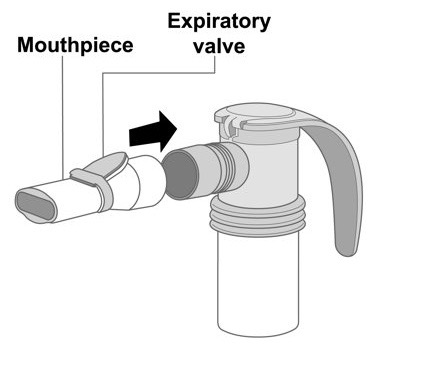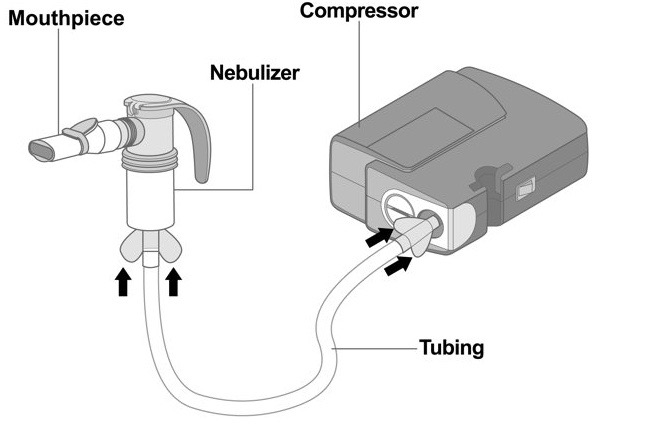How do you use Yupelri inhalation solution?
Medically reviewed by Drugs.com. Last updated on Nov 21, 2024.
I have been prescribed Yupelri to use in a nebulizer for the treatment of chronic obstructive pulmonary disease (COPD). How is it used?
Yupelri (revefenacin) inhalation solution is orally inhaled using a standard jet nebulizer with a mouthpiece connected to an air compressor.
Yupelri (revefenacin) is the first once-daily, nebulized bronchodilator approved in the U.S. for the maintenance treatment of chronic obstructive pulmonary disease (COPD).
COPD is long-term lung disease that includes emphysema, bronchitis, or both. COPD, often caused by smoking, is the third leading cause of death in the U.S. and affects roughly 16 million Americans at a cost of over $50 billion.
Yupelri, classified as a long-acting muscarinic antagonist (LAMA), is a first-line agent for COPD.
- Yupelri was developed for patients who may prefer a nebulized solution over a standard inhaler due to greater ease of use and easier inhalation of the medicine.
- It is for use with a standard jet nebulizer with a mouthpiece connected to an air compressor.
- Yupelri is for for oral inhalation use only and should not be swallowed.
Do not use Yupelri unless your health care provider has taught you how to use it with your nebulizer and you understand the directions. Read the step-by-step instructions for using Yupelri in the Medication Guide that accompanies your medicine. Yupelri is not used to relieve sudden breathing problems and will not replace an inhaled rescue medicine.
Directions:
- Do not mix Yupelri with other medicines in your nebulizer.
- Open the pouch: When ready to use, remove the vial of Yupelri from the foil pouch. Yupelri comes as one 175 mcg vial (in 3 mL) and is used once daily.
- Open the vial: Carefully twist open the top of the vial and use the medicine right away. Squeeze all of the medicine from the vial into the nebulizer cup.
- Attach mouthpiece: Connect the mouthpiece to the nebulizer cup with the expiratory valve facing up.

- Connect nebulizer to the compressor: Firmly insert one end of the tubing to the compressor. Insert the other end of the tubing to the bottom of the nebulizer cup (reservoir).

- Prepare for treatment: Sit in a comfortable, upright position and close your lips around the mouthpiece.
- Begin treatment: Turn on the compressor.
- Breathe in medicine: Breathe in as calmly, deeply, and evenly as possible until you can no longer see the mist in the nebulizer reservoir. The full treatment will take about 8 minutes. When you do not see any mist in the nebulizer, your treatment is finished. Turn the compressor off.
- Clean nebulizer: Clean and store your nebulizer. See the manufacturer’s instructions that come with your nebulizer for how to clean and store your nebulizer.
Related questions
Read next
What foods should be avoided with COPD?
In some people, certain foods have been noted to aggravate symptoms of chronic obstructive pulmonary disease (COPD). These types of foods include: fried foods, carbonated beverages, excessively salty food or too much added salt, some dairy products, cruciferous vegetables (for example: kale, broccoli, cabbage) and preserved meats and cold cuts (with nitrates). Continue reading
What are the 4 stages of COPD?
COPD is now classified using grades, not stages. Grades of COPD are ranked from 1 to 4, ranging from mild to a very severe grade of lung disease based on your results from a breathing test called spirometry. Your healthcare provider may place you into a group (A to D) based on your current symptoms and your chances for flare-ups and hospitalizations. Continue reading
Can severe asthma lead to COPD?
Severe and poorly controlled asthma can lead to damaged lungs which may increase the risk of developing chronic obstructive pulmonary disease (COPD). Symptoms of asthma and COPD may frequently co-exist in smokers and the elderly. Continue reading
Related medical questions
- Prednisone: What are 12 Things You Should Know?
- Why do you not give oxygen to COPD patients?
- What is Fluimucil used for?
- Can vitamin C prevent or treat COVID-19 (coronavirus)?
- What is the difference between emphysema and COPD?
- How long can you be on Symbicort?
- What is the difference between Breztri vs Trelegy?
- What does Symbicort do to the lungs?
- Why does Dupixent cause eye problems?
- How does the Dupixent Myway copay card work?
- Trelegy vs. Breo: How does their use and cost compare?
- How often can I use my Symbicort inhaler?
- Symbicort vs. Advair: How do they compare?
- Is Dupixent an immunosuppressant?
- Does Dupixent cause weight gain?
- How long does it take for Symbicort to work?
- How long can Dupixent stay out of the fridge?
- Trelegy vs Anoro: Which is better?
- Why do insurance companies deny Dupixent?
- When should you use Symbicort?
- How does Dupixent work and what is its mechanism of action?
- Can you drink alcohol on Dupixent?
- Can you take Symbicort and prednisone together?
- Is Wixela Inhub the same as Advair Diskus?
Drug information
Related support groups
- Yupelri (2 questions, 3 members)
- Revefenacin (1 questions, 3 members)
- Chronic Obstructive Pulmonary Disease (135 questions, 490 members)
